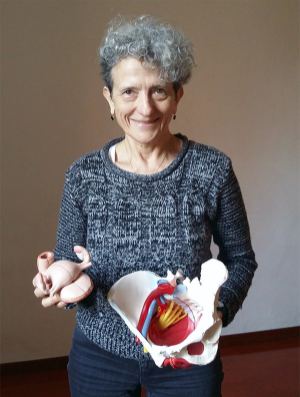Healthy Feet - Comments by Dr. Mara Fusero (of "Kissing a Cork" pelvic floor work fame)
My colleague Paula Alonzo was so excited about Dr. Mara Fuseo’s “Kissing A Cork” pelvic floor lesson, she called a group meeting to share it! Students of my pelvic floor series got to try the lesson very shortly afterwards.
The theory behind “Kiss the Cork” is that all the sphincter muscles, (a ring of muscle surrounding and serving to guard or close an opening or tube, such as the anus or the openings of the stomach) are connected. Lips are connected to the stomach, which is connected to the intestines, which is connected to the colon, which is connected to the pelvic floor, as well as the palms and …. wait for it … the soles of the feet. (Took a while, but we finally got there.)
Dr. Fuseo shared her thoughts on healthy feet in an interview with Julia Kriskovetz for Feldenkrais.com Here are few topical excerpts:
“I used to say that our hands are like water, they adapt to the object they touch. It is the same thing with the feet. Unfortunately, in the last hundred years, we have walked on flat surfaces, so our feet forgot what it means to adapt to a variety of different surfaces. Our balance does not get challenged much, because we mostly walk on flat surfaces. And when we occasionally get to walk on the beach and encounter uneven terrain, we are thrown off, because the feet are stiff and there’s not much differentiation between different parts of the feet. It is as if we always have horse hooves on our feet...
Our body is very intelligent: if there is more pressure on a big toe, our body produces a callus or a hardening on that big toe, to protect that part of the foot. Usually, people go to get a pedicure and get that callus removed. However, if we accept the idea that the body is sending us a warning, saying “Pay attention, you are putting too much weight on this place”, then it would be a much better alternative to go to a Feldenkrais Practitioner to learn how to recover the optimal distribution of the weight on our feet...
There is an important connection between the ankle joint, knee joint, and hip joint. It is not easy to change the position of our hip joint, because the head of the femur is placed very deep inside the acetabulum (its socket). It is much easier to bring about the change through the feet.
There is a direct connection – from feet, to knees, to pelvis and to the spine – with the ultimate goal of supporting the head that floats on top of all these parts. Freedom in the head translates into the freedom of eyes, ears and nose, which allows us to monitor the environment around us. Healthy feet connect to our ability to use our head as a telescope, with all its teleceptors (like the periscope of a submarine). One influences the other...
Moshe Feldenkrais taught so many lessons named “Pillows and Swings” that focus on flexion and extension, rotation, pronation and supination of the feet. It is, of course, belittling to think of these movements only in terms of the feet. It’s important to find connections between feet and other parts of ourselves, e.g. lips and tongue. I am a fan of the pelvic floor explorations and I always try to clarify the connections of the pelvic floor with other parts of the body. The muscles of the soles of the feet are part of the same network of the “ring muscles” (the sphincters), this means that, each time we press on the floor, we need to connect with the activation of our pelvic floor.”
The interview also covers choosing the right shoes, undoing the negative affects of high heels (she is Italian, where apparently women still torture themselves), shoe inserts and the perception that “one leg is longer than the other “(probably not, check the hip alignment) and her suggestion to create a "sensory box” of different textures to walk on and reactivate the feet.
Dr. Mara Fusero is now Educational Director of several Feldenkrais Trainings both in Italy and in Spain and teaches in other Trainings all over the world. Mara is a certified physiotherapist and psychologist and her teaching method and general approach are characterised by her deep respect for the original essence of the Method and her vast knowledge of functional anatomy. She runs her private practice in Milan. Mara is also a certified JKA ® Practitioner and Therapist, Teacher of Perineè, Integration y Movimiento ® (PYM) and a Bones for Life ® Trainer.


